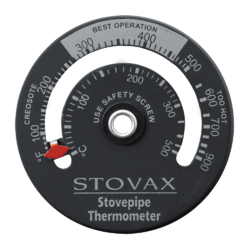Evening all,
Stove fitted 5 weeks ago, first couple of burns very light as per the manual...
"2.1 To allow the appliance to settle, and fixing glues and paint to fully cure, operate the appliance at a low temperature for the first few days. 2.2 Do not touch the paint during the first period of use. 2.3 During this time the appliance may give off some unpleasant odours."
I didn't have any unpleasant odours.
Since then i've been running the stove in the operating temp on my Stovax thermometer between 300-450 *F

All is well until the temp goes over 400 *F, (up until this point I can't smell a thing, its perfect) I then get an unpleasant acrid smell. I'm certain its not smoke which actually smells quite ok in comparison (Eg when reloading) The smell dwindles once the temp drops back to 350 *F and below.
I've done some all day runs and kept it in best operation temps to try and cure the paint once and for all, I also take it up to the 400-450 range every night for a few hours. Yet still it persists.
Whats the longest your stove have took to cure the paint? Any other suggestions?
Cheers
Stove fitted 5 weeks ago, first couple of burns very light as per the manual...
"2.1 To allow the appliance to settle, and fixing glues and paint to fully cure, operate the appliance at a low temperature for the first few days. 2.2 Do not touch the paint during the first period of use. 2.3 During this time the appliance may give off some unpleasant odours."
I didn't have any unpleasant odours.
Since then i've been running the stove in the operating temp on my Stovax thermometer between 300-450 *F

All is well until the temp goes over 400 *F, (up until this point I can't smell a thing, its perfect) I then get an unpleasant acrid smell. I'm certain its not smoke which actually smells quite ok in comparison (Eg when reloading) The smell dwindles once the temp drops back to 350 *F and below.
I've done some all day runs and kept it in best operation temps to try and cure the paint once and for all, I also take it up to the 400-450 range every night for a few hours. Yet still it persists.
Whats the longest your stove have took to cure the paint? Any other suggestions?
Cheers

Last edited by a moderator:


 Oh dear! Not sure if I should believe that or not!
Oh dear! Not sure if I should believe that or not!